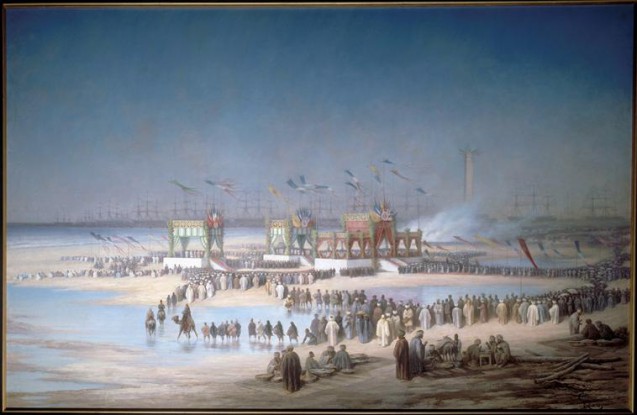Edouard Riou (1833-1900) was a Pre-Impressionist painter, a renowned illustrator of books by Jules Verne and Alexandre Dumas, and a contributor to the weekly newspaper Le tour du monde, and in 1870, at the request of Ferdinand de Lesseps, he created a souvenir album of the Empress’ voyage undertaken for the inauguration of the Suez Canal in November 1869. Dedicated to the Empress, this Voyage pittoresque à travers l’isthme de Suez brought together a series of 25 watercolours accompanied by texts by Marius Fontane (1838-1914), historian, orientalist, journalist and secretary to Ferdinand de Lesseps. Later, in 1896, Edouard Riou decided to paint a gigantic canvas to celebrate the international event of the excavation of the Suez Canal. The painting is a sort of oriental reverie; three grandstands built for the guests of honour at the religious ceremony for the inauguration of the canal on 16 November stand set against a beautiful blue sky. In the foreground, the Egyptian people gathers for the ceremony. In the background, emerging almost out of nowhere, prows of ships ready to sail down the canal prefigure the revolution in economic and diplomatic relations brought about by the Suez Canal. On the following day, 17 November, the imperial yacht L’Aigle led the procession and entered the channel.
The vast human and technical enterprise of the digging of the Suez Canal (1859-1869), which linked the Red and the Mediterranean Seas, was the work of the diplomat Ferdinand de Lesseps (1805-1894). De Lesseps knew Egypt well; indeed he had held various diplomatic posts from 1828 to 1837 and was commissioned by the viceroy Mehmet Ali to ‘finish’ the education of the latter’s son, Saïd. And since he was a cousin of the Empress Eugenie’s mother, de Lesseps also had privileged access to the imperial couple. When his former pupil, the viceroy Said, came to power in 1854, de Lesseps seized the opportunity to revive his project of digging a canal through the Suez isthmus. An Egyptian governmental measure or firman dated 30 November, 1854, granted him permission not only to set up a company for the digging of the channel but also to exploit the canal for 99 years after commissioning, though necessarily pending the final approval of the Turkish sultan, the Egyptian viceroy sovereign. A second text, signed 5 January, 1856, defined the channel as a neutral waterway, and opened it to all merchant vessels without distinction of nationality, in return for payment of a transit fee. In December 1858, the Suez Canal Universal Company was finally constituted, and in Europe shares in the project were snapped up. In England, however, the government feared the development of the French influence in Egypt that could have harmed British interests in India, and was far from supporting the project; indeed it launched a campaign against Lesseps.
Nevertheless, the ceremonial first blow of the pickaxe inaugurating work on the channel was struck near Pelusium on Easter Monday, 25 April, 1859. Ishmael, successor of Said who died in 1863, challenged the previous agreements with de Lesseps, but the mediation of Napoleon III relieved tensions. The agreement of 6 July, 1864, granted compensation of 84 million gold francs and ceded 10,864 hectares to the Canal Company; the freshwater canal built to feed the construction site was handed to Egypt. On 19 March, 1866, a firman of Sultan Abd-ul-Aziz ratified this agreement.
Once diplomatic tensions were eased, work could continue. On 15 August, 1869, the waters of the Mediterranean finally mingled with those of the Red Sea in the Bitter Lakes. The maritime canal was 164 km long, from Suez to Port Said, located just west of Pelusium, 54 metres wide, 8 metres deep. Three cities were founded (Suez, Ismailia, Port Said) and two ports equipped (Suez and Port Said).
Whilst the opening of the channel by the Empress Eugenie cemented Franco-Egyptian relations, Napoleon III also needed to tread carefully in his relationship with the Sublime Porte, since the latter had become increasingly annoyed with the viceroy of Egypt’s desires for autonomy, of which the Suez Canal in the end would become the symbol. Tensions were in fact only put to one side for the period of the opening ceremonies. The Empress Eugenie was first received at Constantinople by Sultan Abd-ul-Aziz. She then headed for Alexandria, landing 22 October, 1869. About three weeks later (16 November) she reached the new town of Port Said, which hosted the first religious ceremonies for the inauguration. The next day, to the thundering sound of a canon salute, the imperial yacht L’Aigle undertook the first voyage down the canal, followed by an impressive flotilla of forty ships bearing the Viceroy, the Emperor of Austria, the Crown Prince of Prussia, the princes of the Netherlands and Hanover, and the ambassadors of England and Russia. In the evening, the L’Aigle dropped anchor off the other new town, Ismailia, in the Temsah Lake.
Irène Delage
November 2013
Also see our special dossier on the Suez Canal


